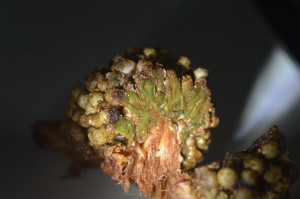Philip Bell-Doyon and our colleagues just published a recent paper on the coralloid root of Zamia pseudoparasitica.

Using a combination of Sanger-sequencing, 16S metagenomics and whole-genome sequencing, we have elucidated the bacteriome of this Panamanian endemic species. One hundred and sixty‐five amplicon sequence variants (ASVs) were found in at least two of our 27 samples amplified for 16S. Nostocales, Rhizobiales, and Acetobacterales were the three most diverse and abundant orders of bacteria found within the coralloid roots, and the candidate phylum WPS‐2 was also found in many samples. The isolate has genes putatively involved in symbiotic signalling, hormogonium differentiation, ammonium transport, nitrogen fixation, heterocyst differentiation, sulfate transport, and secondary metabolites. Although dominated by organisms with the capacity to fix nitrogen, coralloid roots are also inhabited by a diverse community of other taxa which may also play biologically important roles.
Here is the paper: https://onlinelibrary.wiley.com/doi/10.1002/edn3.66